How to Pack for International Travel Like a Pro
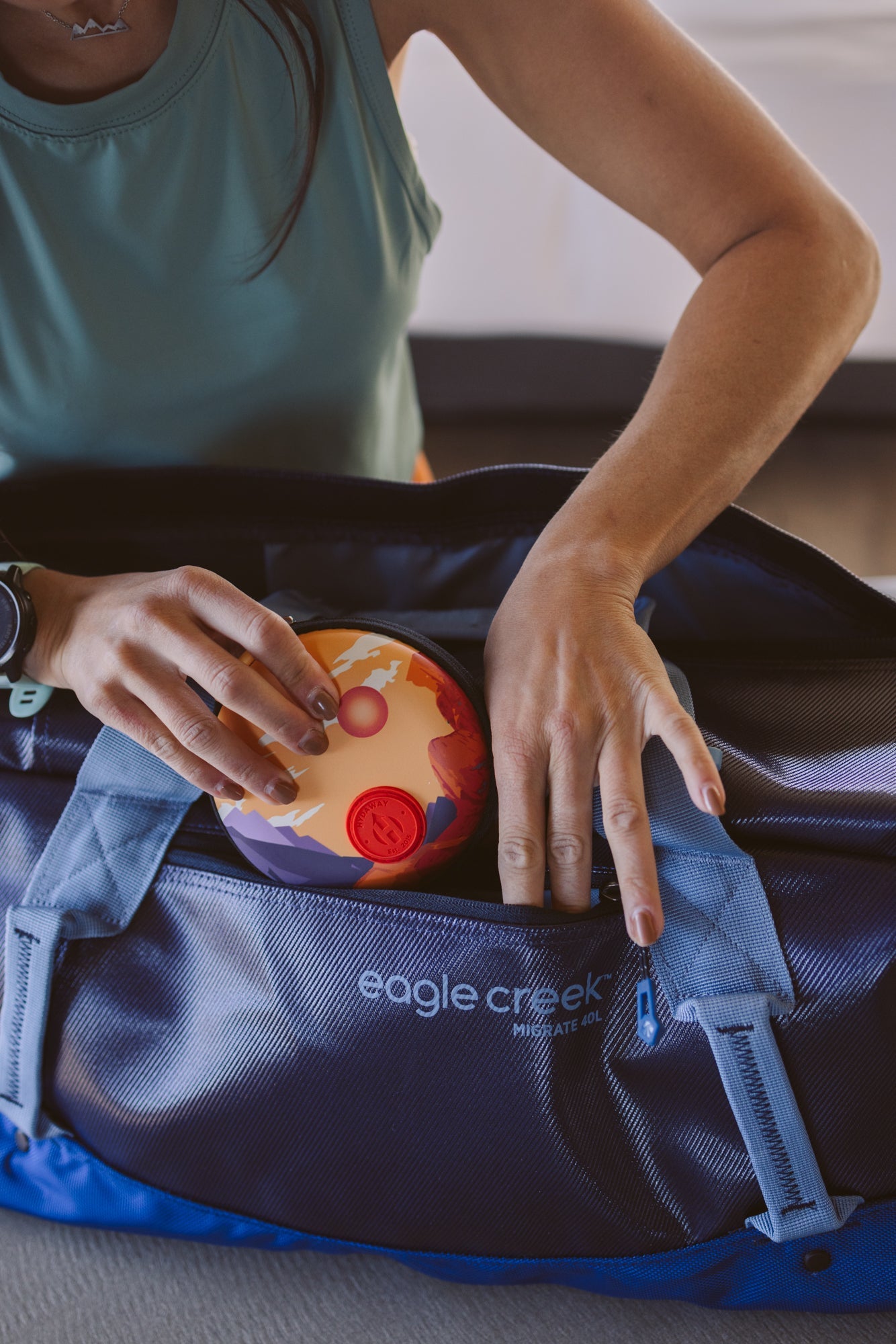
I've found that the real secret to packing for a big international trip isn't about finding the perfect suitcase—it's about a simple mental shift. Stop asking "what if I need this?" and start asking "will I actually use this?" It's all about packing with intention, focusing on a core set of versatile essentials you know you'll need, instead of trying to plan for every single just-in-case scenario.
Your Smart Packing Strategy Starts Here
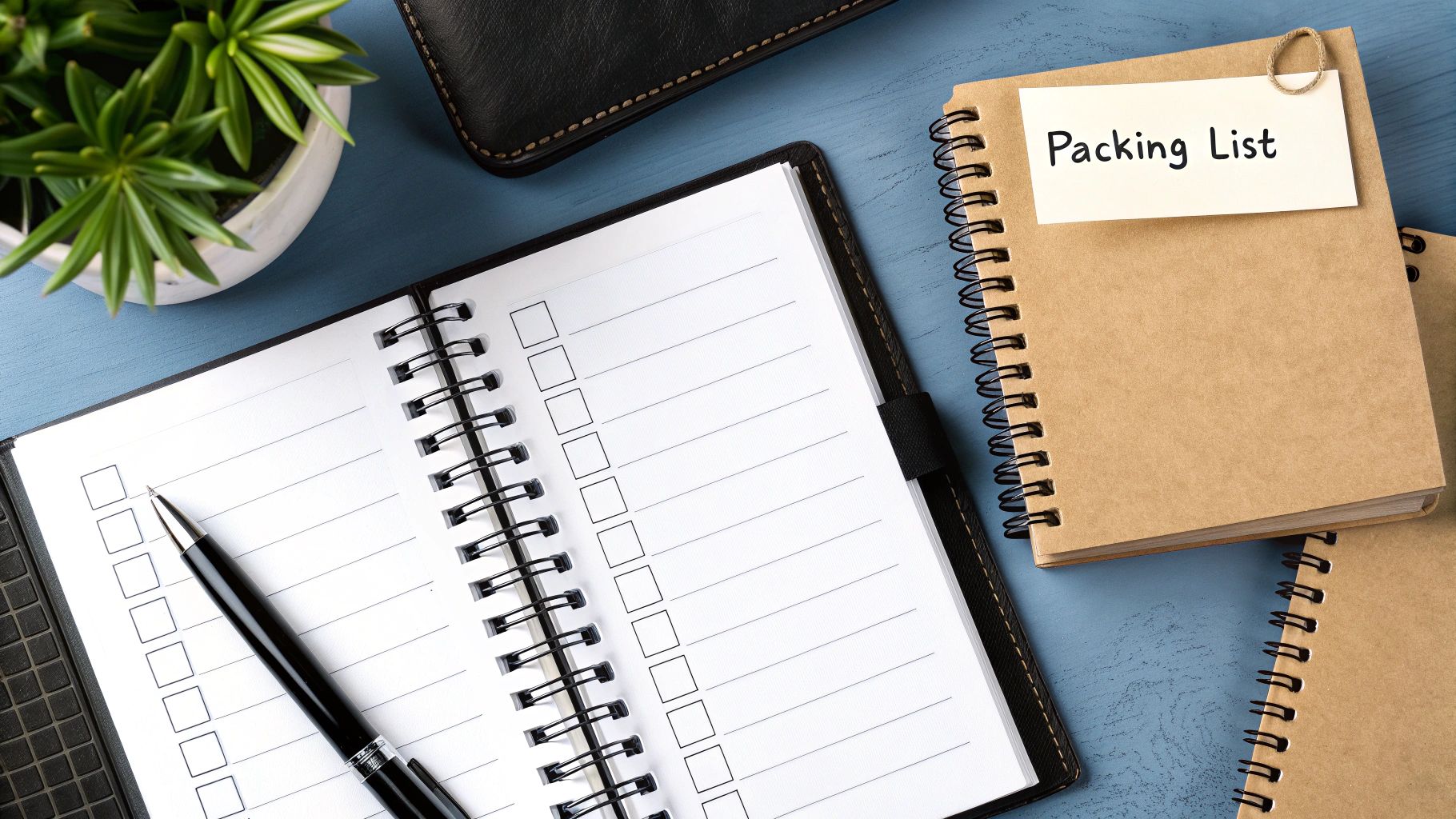
Before a single item even touches your suitcase, you need a strategy. This isn't just about jotting down a list. It's about getting into a minimalist mindset that values freedom and mobility over having a closet's worth of options on the road. Let’s be real: overpacking doesn’t just weigh down your bag, it weighs down your entire trip.
It's not just you, either. The stress of travel is deeply connected to packing. Recent surveys show that nearly 70% of people think packing is one of the most stressful parts of their vacation. Lugging around too much stuff just adds a physical burden and a dose of 'decision fatigue' when you're faced with too many choices each morning. You can read more about why packing is so stressful on TheGirlfriend.com.
Build a Versatile Capsule Wardrobe
A capsule wardrobe is your single best defense against the urge to overpack. The whole idea is to curate a small collection of essential, versatile pieces that you can mix and match to create a surprising number of outfits.
- Choose a Base Color Palette: Start with one or two neutral colors like black, navy, or beige. These will be for your main items like pants, shorts, or jackets.
- Add Accent Colors: Next, pick a few complementary colors for tops and accessories. This is how you add personality and variety without the bulk.
- Focus on Layers: Forget that one giant, heavy coat. A smarter approach is packing thin layers you can combine—think a long-sleeve tee, a fleece, and a packable waterproof shell. This setup can handle almost any weather you'll encounter.
For a spring trip to Italy, for example, your capsule might be built around neutral linen trousers and a versatile dress. Add a few coordinating tops and a light jacket, and suddenly you have outfits for days. The key is making sure every piece works with at least two others.
The core principle is simple: pack items that serve multiple purposes. Think of a scarf that can be an accessory, a blanket on a chilly flight, or a respectful head covering when visiting a historic cathedral.
Pack Smarter with Multi-Purpose Gear
This philosophy goes way beyond your clothes. Every single item in your bag needs to earn its spot. Ditch the bulky, single-use stuff for compact, reusable alternatives that give you maximum utility.
A perfect example is your water bottle. Instead of constantly buying single-use plastic bottles at your destination, a HYDAWAY collapsible water bottle is an absolute game-changer for travelers. It's full-sized when you need it for a day of sightseeing but collapses down to just over an inch thick when empty, easily slipping into a pocket or daypack. Imagine exploring Tokyo for a day; you can fill it up at your hotel, drink it down, and then collapse it to fit into your smallest bag while you navigate the crowded subways. This not only saves a ton of space but also helps you travel more sustainably. If you're passionate about this, check out our guide on how to reduce plastic waste while traveling.
Choosing the Right Luggage and Gear
Your luggage isn't just a bag; it's your mobile command center for the entire trip. Get this choice right, and everything else falls into place, from breezing through a crowded Tokyo train station to navigating the charming, cobblestoned streets of Rome. The perfect bag really comes down to your unique travel style and where you're headed.
Put it this way: a sleek, hardshell spinner suitcase is a dream for gliding through modern airports and checking into hotels. But try hauling that same suitcase up five flights of stairs to a Parisian flat, and suddenly a comfortable travel backpack feels like the smartest decision you've ever made.
Hardshell vs Softshell Luggage
The hard-or-soft-shell debate is a classic for a reason. Hardshell cases give you amazing protection for anything fragile and are often surprisingly light. On the other hand, softshell luggage offers more flexibility, especially with those handy exterior pockets perfect for stashing last-minute items.
- Hardshell: Your best bet for protecting electronics and souvenirs. Plus, they’re a breeze to wipe clean.
- Softshell: Gives you a little more wiggle room, letting you squeeze in that one extra purchase you couldn't resist.
- Travel Backpack: The undisputed champ for multi-destination trips where mobility is everything.
Sticking to just a carry-on is the ultimate goal for many of us. It forces you to be intentional with your packing and saves you from the soul-crushing wait at the baggage carousel. But let's be realistic—longer international trips often mean packing more. Recent travel trends show that while carry-on-only travel is popular for short trips, many people still check bags for more complex international itineraries, making smart packing essential no matter your luggage size.
Essential Gear That Makes a Difference
Beyond the bag itself, a few key pieces of gear can totally transform your packing game from chaotic to controlled. These small investments pay off big time in organization and convenience once you’re on the road.
Packing cubes are pretty much non-negotiable for keeping your suitcase from exploding. They compartmentalize your clothes, making it easy to find what you need without dumping everything out. Another absolute must-have is a universal travel adapter—the last thing you want is to arrive somewhere new and not be able to charge your phone.
The smartest gear choices are the ones that solve a real travel problem without adding a bunch of bulk. Think compact, multi-functional, and tough enough to handle the journey.
This is where innovative, space-saving items really get to shine. Instead of a clunky travel mug taking up precious real estate, consider the HYDAWAY Collapsible Drink Tumbler. It’s perfect for your morning coffee at a local market in Bangkok, and when you’re done, it collapses into a slim, one-inch disk that vanishes into your daypack. It's a simple swap that frees up a surprising amount of space, allowing you to focus on your experience, not your stuff. For more inspiration on packable hydration, check out our guide on the best collapsible water bottles for travel.
When you're deciding what else makes the cut, always lean toward versatile and compact options. For example, look into lightweight and quick-drying beach towels perfect for travel; they save a ton of space compared to their bulky cotton cousins.
Mastering the Art of Efficient Packing
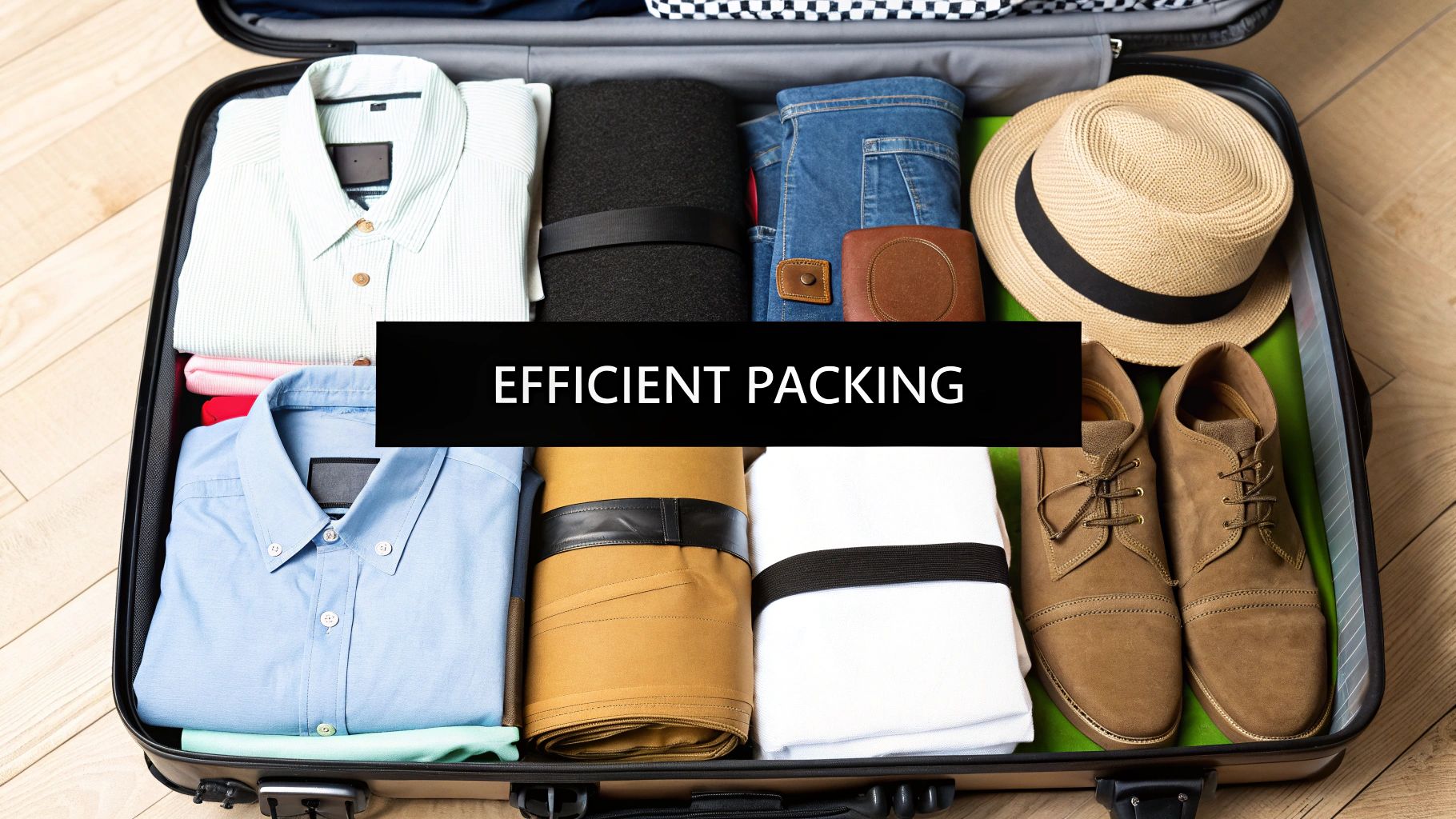
This is where your smart packing list meets the real world. With a few solid techniques, you can fit way more into your bag than you'd think, all while keeping things organized and surprisingly wrinkle-free. It’s not magic, just a better approach that turns your suitcase into a tidy, portable closet.
The first skill every seasoned traveler swears by is rolling their clothes. Tightly rolling things like t-shirts, pants, and casual dresses compresses the fabric and cuts down on wrinkles far better than traditional folding. For structured items like blazers, a careful fold is still the way to go, but for most of your wardrobe, rolling is king.
Create a Modular System with Packing Cubes
If you're wondering how to really pack for an international trip without losing your mind, packing cubes are the answer. These little zippered containers let you compartmentalize everything, creating a neat, modular system inside your luggage.
Think about it: instead of rummaging through a jumbled mess to find a clean pair of socks, you just grab your "smalls" cube. This method is a total game-changer for staying organized on the road, making it easy to find what you need without exploding your entire bag.
- Categorize Your Cubes: Give each cube a job. One for tops, another for bottoms, one for underwear and socks, and maybe a separate one for gym clothes.
- Use Compression Cubes: For puffier items like sweaters or light jackets, compression cubes are a brilliant investment. They have a second zipper that squeezes out all the extra air, saving you an incredible amount of space.
By grouping similar items in cubes, you’re basically creating drawers within your suitcase. This makes unpacking at your destination totally optional—you can live right out of your bag without the chaos.
Fill Every Nook and Cranny
Once your clothes are rolled and cubed, it's time to play a little real-life Tetris. The goal here is to fill every last bit of empty space. This not only lets you pack more but also stops your stuff from shifting around and getting tossed about in transit.
Start by placing your heaviest items—like shoes or your main toiletry bag—down by the wheels of your suitcase. This simple move creates a lower center of gravity, which makes your bag way more stable and less likely to tip over while you're navigating a busy airport. Then, slot in your packing cubes around them.
Now, hunt for the gaps. Those small, awkward spaces are goldmines for stashing smaller items.
- Roll up your socks and stuff them inside your shoes.
- Wedge charging cables and adapters into the crevices between cubes.
- Slide slim items like a book or a collapsed HYDAWAY water bottle down the sides of the suitcase. It takes up almost no room and ensures you're ready to hydrate the moment you arrive.
This meticulous approach makes sure no inch of space goes to waste. It’s a principle that’s especially crucial for any kind of adventure travel, where every piece of gear counts. You can find more space-saving tips in our guide on using collapsible water containers for camping, which uses the same packable mindset.
Ultimately, getting these methods down will make your entire trip smoother, right from the moment you zip up your bag.
Packing Your Carry-On Like a Pro
Think of your carry-on as your travel lifeline. Your checked bag can handle the bulk of your stuff, but this bag? This is where you keep everything you absolutely cannot afford to lose. It's your personal insurance policy against lost luggage, endless flight delays, and all the other little hiccups that travel can throw at you. A well-packed carry-on is the key to starting your trip off right, no matter what.
It should be home to your most critical items. We're talking all your essential travel documents—passport, visa, flight confirmations—plus any prescription medications you rely on. I always recommend packing a simple change of clothes, too. You'd be amazed how much better a fresh shirt and underwear can make you feel after a 12-hour flight or during an unexpected layover.
Navigating Liquids and Staying Hydrated
Let's talk about the biggest carry-on headache: the liquids rule. Every traveler knows the drill. All your liquids, gels, and aerosols have to be in containers of 3.4 ounces (100 milliliters) or less, and they all have to cram into a single, clear, quart-sized bag. This usually means buying those tiny, overpriced travel toiletries that just create a mountain of plastic waste.
A much smarter strategy is to ditch the liquids altogether. Solid shampoo bars, conditioner bars, and even toothpaste tablets are game-changers. They free up a ton of space in that tiny plastic bag and, best of all, there's zero chance of a gooey shampoo explosion all over your clothes.
The real pro move is planning for hydration after you clear security. Airport water fountains are free, but buying single-use plastic bottles is expensive and wasteful. Your carry-on is the perfect place for a smart, reusable solution.
This is exactly where something like the HYDAWAY collapsible water bottle becomes an indispensable piece of gear. It squishes down completely flat when it's empty, taking up virtually no space as you go through the TSA checkpoint. Once you’re on the other side, just expand it, fill it up at a water station, and you're set to stay hydrated for your entire flight without adding to the plastic problem. No more paying $5 for a bottle of water at the gate.
To keep everything straight, here's a quick checklist of the non-negotiables that should always live in your carry-on bag.
Essential Carry-On Checklist
| Category | Essential Items | Pro Tip |
|---|---|---|
| Documents | Passport/Visa, Boarding Pass (digital & paper), Hotel/Rental Car Confirmations | Keep digital copies in a cloud service and send a copy to a trusted contact back home. |
| Health & Wellness | Prescription Medications, Basic First-Aid (pain relievers, band-aids), Hand Sanitizer | Always pack enough medication for your entire trip, plus a few extra days, in their original bottles. |
| Electronics | Phone, Laptop/Tablet, E-Reader, Portable Charger, All Necessary Cords, Travel Adapter | A portable power bank can be a lifesaver during long layovers or on planes with no outlets. |
| Comfort | Change of Clothes (shirt, socks, underwear), Travel Pillow, Eye Mask, Headphones, Reusable Water Bottle | Pack clothes made of wrinkle-resistant fabric like merino wool or certain synthetics. |
| Valuables | Wallet (credit cards, cash), House/Car Keys, Jewelry, Anything Irreplaceable | Never, ever put valuable or sentimental items in your checked luggage. Period. |
Having these items with you gives you peace of mind, knowing that even if your checked bag takes a scenic detour, you've got everything you truly need to start your adventure.
Organizing Your Tech and Comfort Items
In this day and age, landing in a foreign country with a dead phone or laptop is more than an inconvenience—it's a real problem. Your carry-on should be the dedicated home for all your electronics: laptop, camera, e-reader, you name it. And just as crucial: every single charger and adapter they need to function. A little organization here goes a long way.
This visual guide breaks down a dead-simple, three-step process for getting your electronics in order so you can find the right cable in seconds.
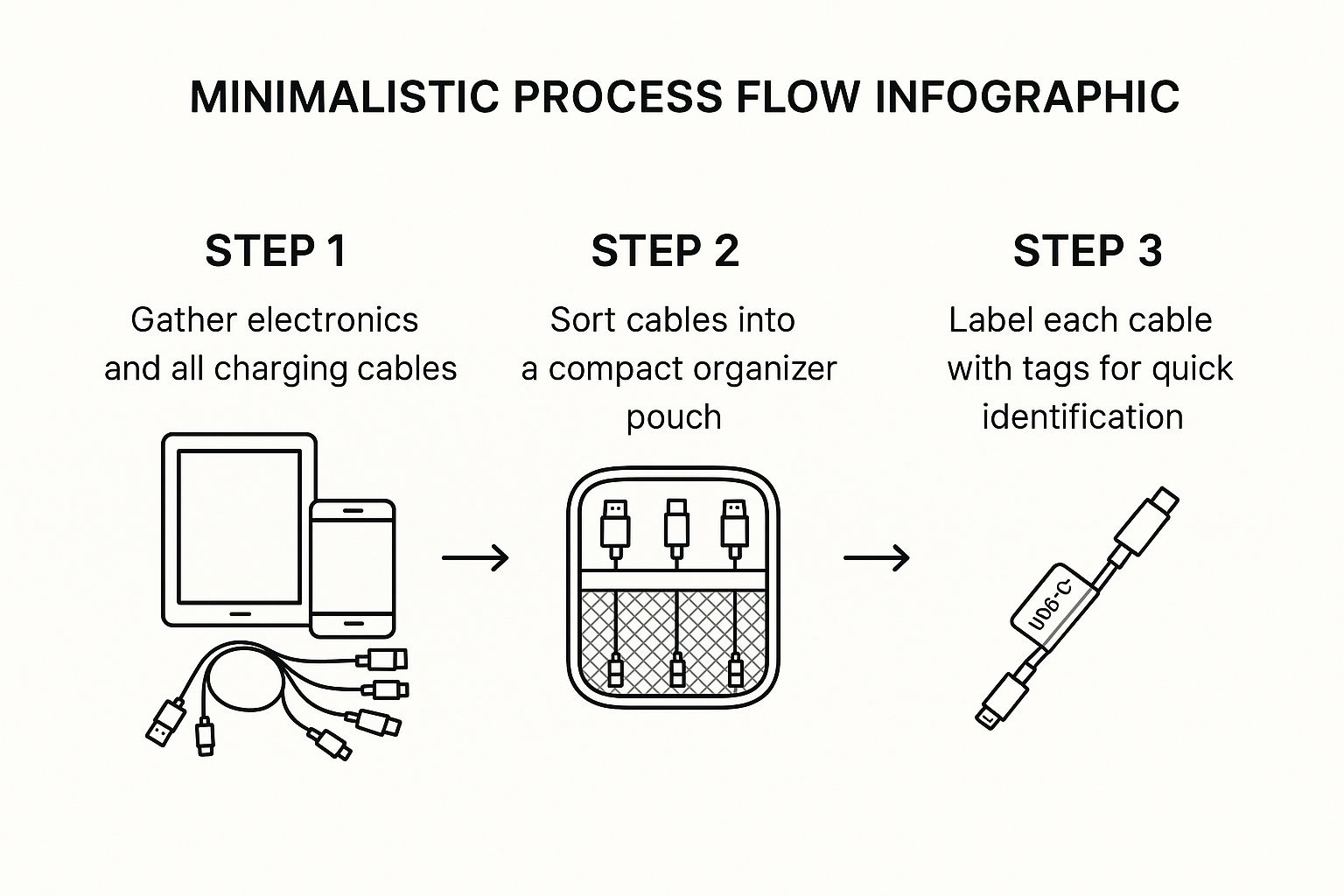
Using this method turns that tangled nest of wires into a simple grab-and-go system. No more frantic digging through your bag mid-flight. To round out your carry-on, toss in a good travel pillow, an eye mask, and some noise-canceling headphones to create your own little bubble of comfort in the sky.
The Ultimate International Packing Checklist
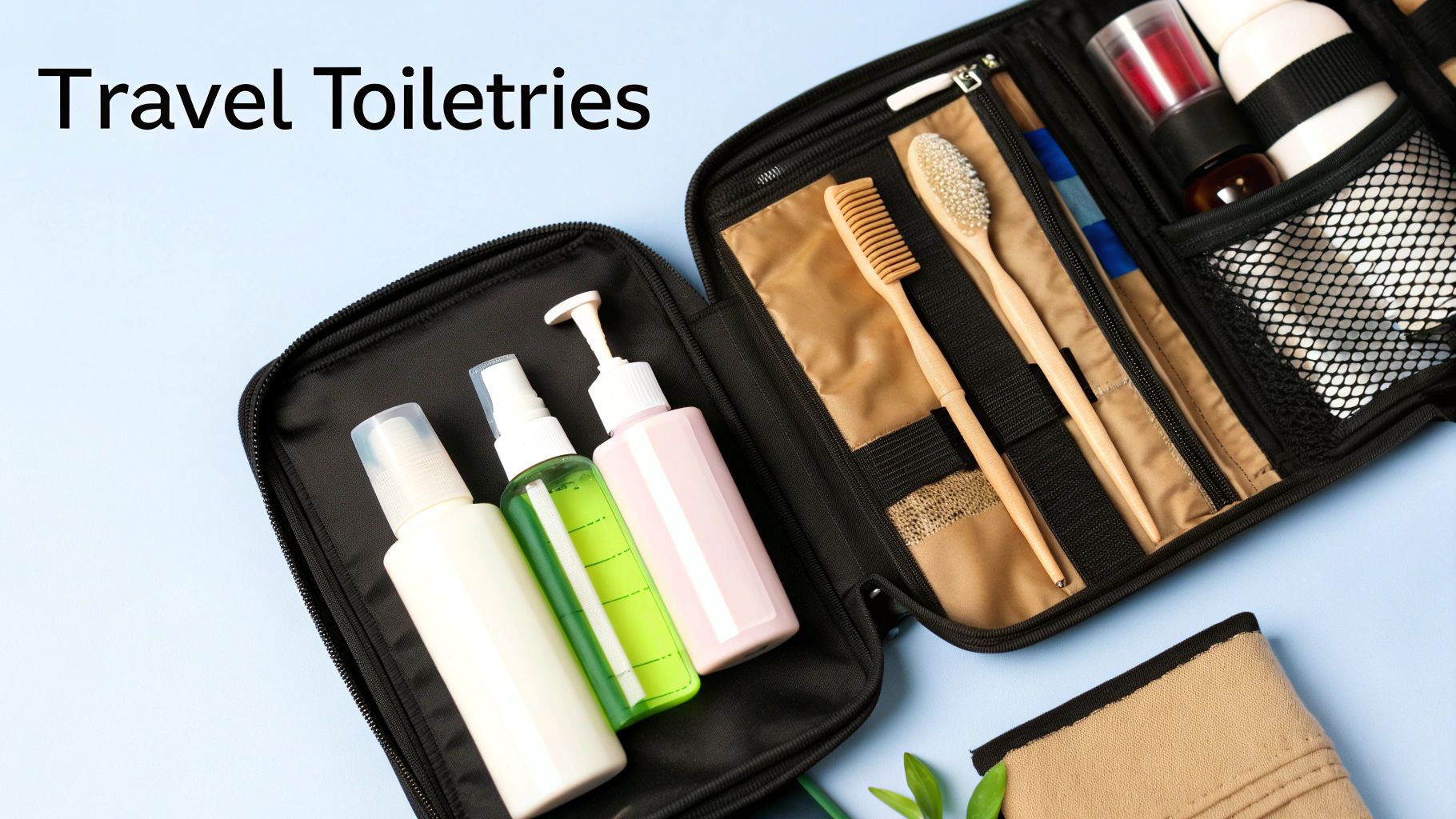
We've all been there. That last moment before you zip up your suitcase, a wave of panic washes over you—what did I forget? It's a universal travel anxiety, but it doesn’t have to be your reality.
A solid, definitive checklist is your best friend here, turning that last-minute dread into confident peace of mind. Instead of guessing, you’re systematically making sure every critical item is accounted for.
If you’ve ever worried about forgetting something, you’re in good company. Recent studies confirm what we all know: the vast majority of travelers get anxious about leaving key items behind, often forgetting simple but crucial things like phone chargers, toothbrushes, and sunscreen. You’re definitely not alone in this.
Essential Documents and Money
Let's start with the non-negotiables. Mess this part up, and your trip might be over before it even begins. Seriously, double and triple-check everything here.
- Passport and Visas: First things first, check your passport’s expiration date. Many countries require it to be valid for at least six months after your planned return. This catches so many people out.
- Physical and Digital Copies: Snap photos of your passport, driver's license, and credit cards. Toss them in a secure cloud folder like Google Drive or Dropbox. It's a lifesaver if the real things go missing.
- Credit Cards and Debit Cards: Give your banks a quick heads-up about your travel dates through their mobile app or website. This simple step can prevent them from flagging your overseas purchases as fraud and freezing your accounts.
- Local Currency: Always try to land with a little local cash. It’s perfect for a taxi, a snack, or a bottle of water right after you get off the plane, before you've had a chance to find an ATM.
Clothing and Footwear
Think versatility. Your clothing choices should be all about your destination’s climate and what you'll actually be doing. The golden rule is to prioritize layers and multi-purpose items over things you’ll only wear once.
- Tops: A few casual tees, at least one long-sleeve shirt for layering or sun protection, and one slightly nicer option for a good dinner out.
- Bottoms: One trusty pair of jeans or versatile travel pants is a must. Add shorts or a skirt if the weather calls for it.
- Layers: A cozy fleece or a lightweight sweater is non-negotiable. Pair it with a packable, waterproof jacket, and you're ready for almost anything.
- Underwear and Socks: Pack for about 7-10 days. For longer trips, just plan on doing a load of laundry. It’s way better than overstuffing your bag.
- Footwear: Stick to three pairs max: comfortable walking shoes you can wear all day, a pair of sandals or flip-flops, and a dressier option if you know you’ll need it.
Pro Tip: As you build your ultimate packing checklist, remember to factor in country-specific requirements. For instance, understanding the customs regulations when moving to the UK can prevent major headaches and ensure you don’t pack prohibited items.
Health and Toiletries
Save space and avoid airport security hassles by sticking to travel-sized containers whenever possible. You can always buy more shampoo when you get there.
- Prescription Medications: Keep these in their original, labeled bottles. It’s also wise to bring a copy of your prescription, just in case.
- Basic First-Aid Kit: You don’t need a full paramedic bag, but some pain relievers, bandages, antiseptic wipes, and blister treatment can be a real trip-saver.
- Toiletries: The basics—toothbrush, toothpaste, deodorant, and any skincare items you can't live without.
- Sunscreen and Insect Repellent: These can be shockingly expensive or hard to find in some destinations. It's often best to bring your own.
Electronics and Miscellaneous Gear
These are the little things that keep you connected, charged up, and comfortable on the road. Don't let them become an afterthought.
- Universal Travel Adapter: An absolute must-have. There's nothing more frustrating than having a dead phone and the wrong plug.
- Portable Power Bank: A lifesaver for long days of sightseeing when you're using your phone for maps, photos, and everything in between.
- All Necessary Chargers: Do a quick inventory: phone, camera, laptop, e-reader. Make sure every device has its corresponding cable.
- Reusable Water Bottle: Staying hydrated is key. A HYDAWAY collapsible bottle is perfect for travel because it takes up virtually no space when empty, making it a no-brainer to pack.
- Combination Lock: A small, simple lock gives you peace of mind, whether you're securing your bag in a hostel locker or at a local gym.
Answering Your Biggest International Packing Questions
Even after years of globe-trotting, a few questions always seem to pop up before a big international trip. Let's tackle those nagging little worries head-on, so you can zip up your suitcase with total confidence.
How Can I Stop Overpacking for a Long Trip?
This is the big one, isn't it? The secret is to ruthlessly fight that "what if" voice in your head. Instead, focus on building a super versatile, mix-and-match capsule wardrobe around a few neutral base colors. It's amazing how much less you need when everything works together.
The real game-changer? Just plan on doing laundry. Seriously. Making that one decision can literally cut your clothing list in half. And don't forget to pack items that pull double-duty. A simple pashmina or lightweight scarf can be a fashion statement one day, an airplane blanket the next, and a respectful head covering when visiting religious sites.
My best advice is to lay everything you think you need on your bed. Then, pick up each item and ask, "Will I definitely, one hundred percent use this?" If there's even a flicker of hesitation, it stays home. You'll thank yourself later.
What’s the Best Way to Pack Toiletries so They Don’t Explode?
We’ve all been there—opening a suitcase to find a shampoo-pocalypse. Thankfully, it's almost entirely preventable. Your first and best move is to go solid wherever you can. Shampoo bars, conditioner bars, solid perfumes... these are a traveler's best friend. No spills, and they don't count toward your liquids limit. Win-win.
For any must-have liquids, decant them into smaller, leak-proof bottles under that crucial 100ml/3.4oz limit. Here's a pro tip: before twisting the cap on, put a small square of plastic wrap over the bottle's opening. Then screw the lid on tight over it. Finally, corral everything inside a truly waterproof toiletry bag. It’s your final firewall against any potential leaks.
Are Packing Cubes Actually Worth the Hype?
Yes. A thousand times, yes. If there's one "secret weapon" for mastering how to pack for international travel, it's packing cubes. They completely transform your suitcase from a chaotic jumble into a neat, organized set of drawers.
- Standard Cubes: I use one for tops, one for bottoms, and another for socks and underwear. Finding a specific shirt becomes a two-second job.
- Compression Cubes: These are next-level. They have an extra zipper that squishes all the air out, making bulky items like sweaters surprisingly compact.
This system is a lifesaver. You can grab what you need without destroying your perfectly packed bag, which saves a ton of time and sanity when you're on the move.
How Do I Pack for a Trip with Wildly Different Climates?
The magic word is layering. Forget that massive, space-hogging winter coat. Instead, think in terms of multiple, thin, high-performance layers that you can combine in different ways.
Imagine a trip to Peru where you're exploring humid Lima one day and hiking the chilly Andes the next. You don't need two separate wardrobes. Pack a thermal base layer, a couple of long-sleeved shirts, a fleece mid-layer, and top it off with a lightweight, waterproof, and windproof shell. This combo can handle everything from a breezy coastline to a high-altitude trek. It's a much smarter, more space-efficient way to stay comfortable than packing bulky, single-purpose outfits for every possible weather scenario.
Ready to pack smarter, lighter, and more sustainably? The award-winning collapsible gear from HYDAWAY is designed for the modern traveler. Ditch the bulk and discover a world of convenience with our ultra-portable water bottles, tumblers, and more. Explore the collection and travel better.



